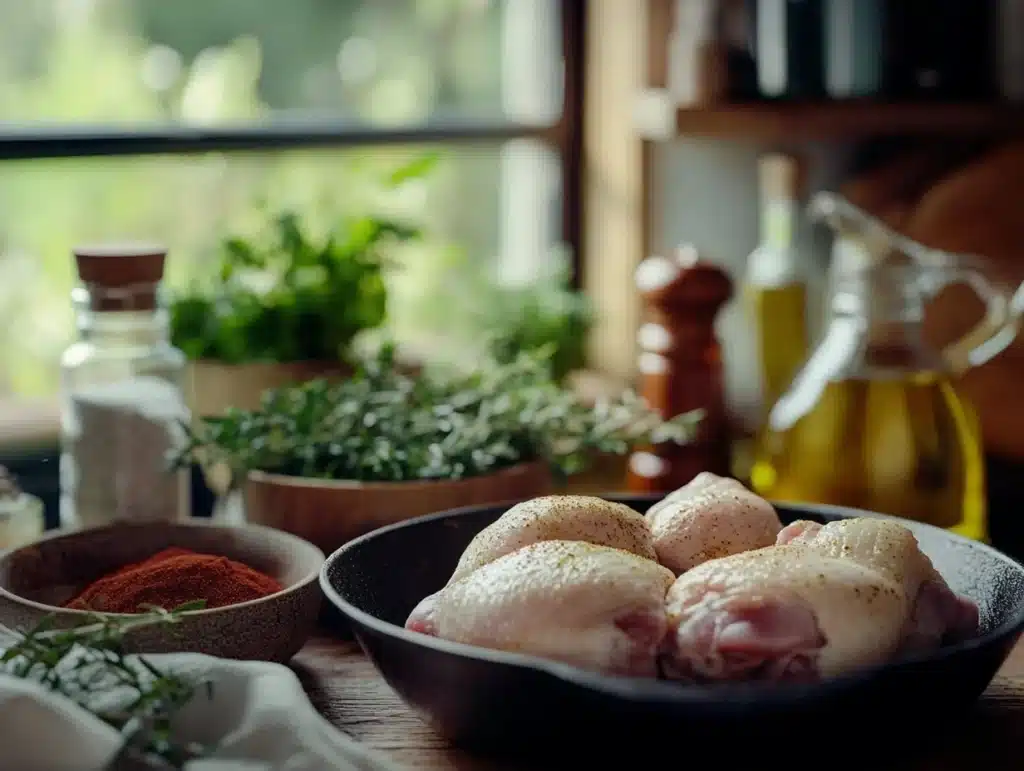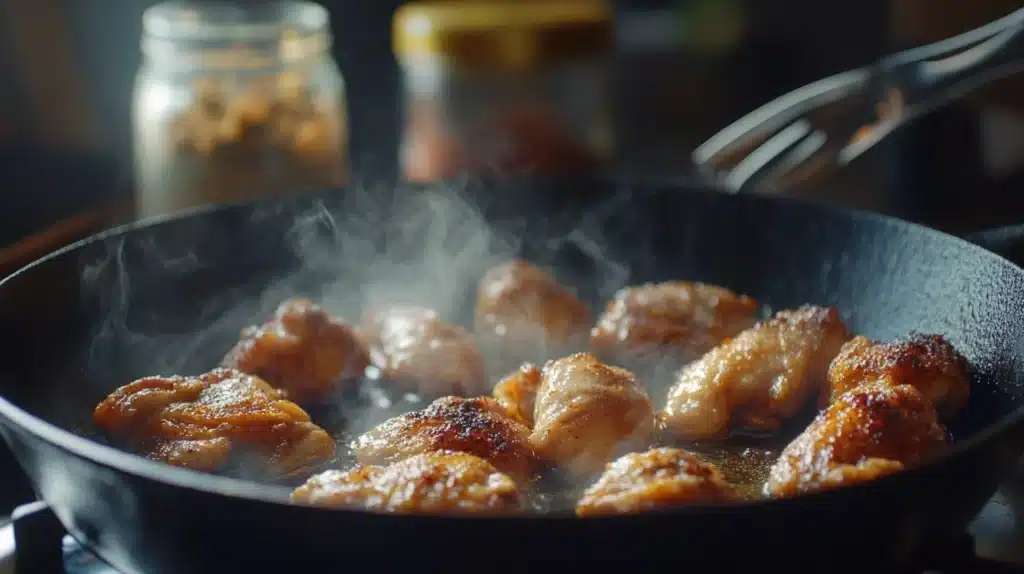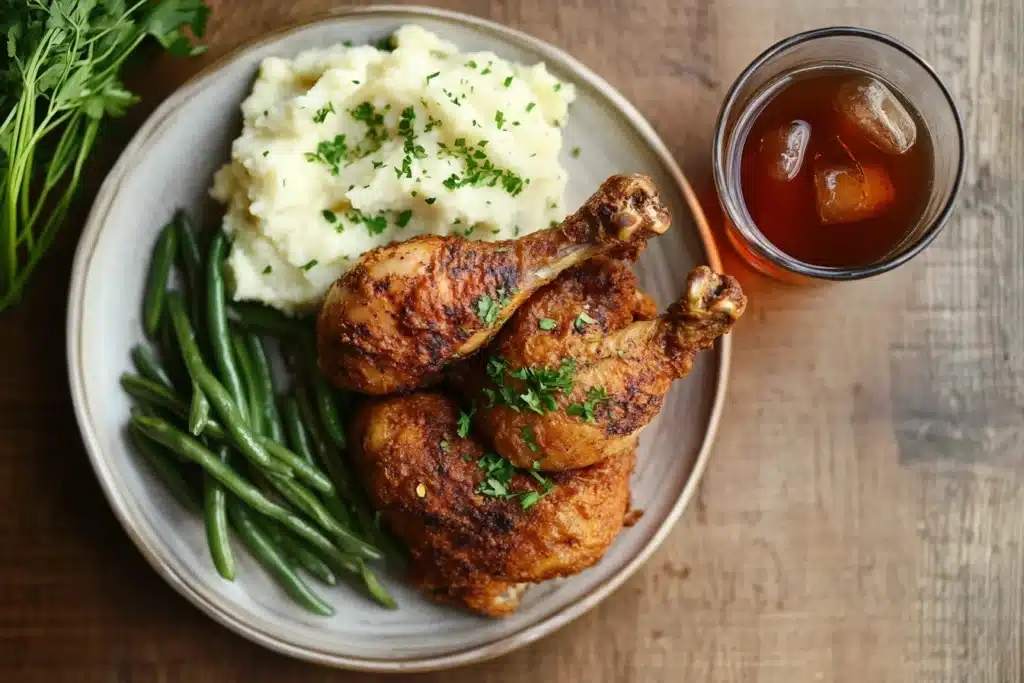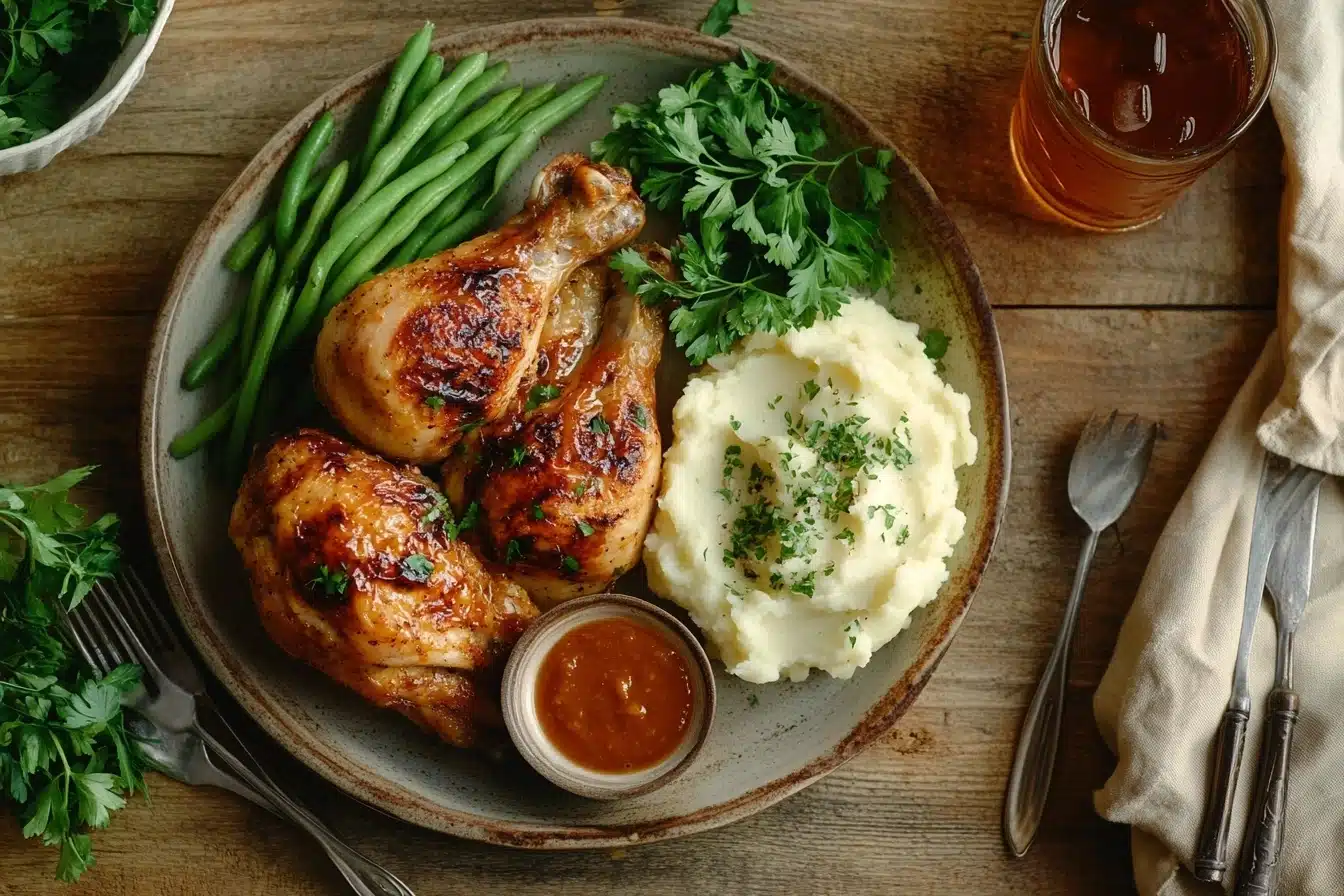Mastering the art of pan-fried chicken is simpler than it seems—especially when you know the secrets to achieving that golden, crispy crust and juicy center. This guide is packed with step-by-step advice, from choosing the best chicken cuts to pairing your dish with the perfect sides and sauces. Along the way, we’ll uncover common pitfalls to avoid, explain the science behind the process, and provide exciting seasoning ideas. Whether you’re a beginner or an experienced cook, there’s something here to level up your skills in the kitchen.
What Makes Pan-Fried Chicken Irresistibly Delicious?
The Unique Flavor Profile of Pan-Fried Chicken
There’s something undeniably satisfying about the savory taste of crispy chicken. The combination of well-seasoned, tender meat and a crackly, golden crust creates a flavor explosion that hits all the right notes. When you pan-fry chicken, the oil enhances the natural flavors while locking in moisture. Every bite offers a perfect balance of crunch and juiciness, which is why this dish is so loved.
Texture: Crispy on the Outside, Juicy on the Inside
What really sets pan-fried chicken apart is the texture. Achieving that delicate, crunchy coating while keeping the inside tender and juicy is the ultimate goal. The secret lies in the frying method and the interplay of heat, moisture, and fat. When done right, each piece feels like a harmonious blend of contrasts—crispy yet soft, crunchy yet moist.
Why Pan-Frying Is a Popular Cooking Method
Unlike deep-frying, pan-frying uses less oil, making it a practical choice for home cooks. Plus, the method allows for better control over the cooking process, ensuring that your chicken doesn’t end up greasy or overcooked. Many people also prefer the rustic charm of pan-frying, as it produces a more artisanal finish compared to commercial frying methods.
How to Choose the Best Chicken Cuts for Pan-Frying
Bone-In vs. Boneless Chicken
The choice between bone-in and boneless chicken can impact both flavor and cooking time. Bone-in chicken, like thighs or drumsticks, delivers a deeper, richer taste as the bones release natural juices during cooking. However, it requires more time to cook through evenly. On the flip side, boneless chicken, such as breasts or tenders, cooks quickly and is easier to handle, especially for beginners. Each type offers its own perks, so your choice depends on personal preference and how much time you’ve got to spare.
Which Cuts Work Best? (Thighs, Breasts, Drumsticks)
When it comes to pan-frying, thighs are a favorite because they’re naturally juicy and forgiving if slightly overcooked. Breasts, though leaner, can still turn out moist if handled correctly. Drumsticks, with their bold flavor, are excellent for those who enjoy a hearty, meaty bite. Opt for uniform cuts to ensure even cooking, and if you’re in doubt, thighs are often a foolproof choice for beginners aiming for crispy perfection.
Organic, Free-Range, or Conventional Chicken: Does It Matter?
Yes, the type of chicken you choose matters! Organic and free-range chickens typically offer better texture and flavor, as they’re raised under healthier conditions. Conventional chicken is a budget-friendly option but might lack the same depth of flavor. Keep in mind, organic or free-range options often work better with simple seasonings, as their natural taste shines through. While it’s not a must to splurge, choosing higher-quality chicken can elevate your pan-frying game.
Essential Ingredients for Perfect Pan-Fried Chicken
Choosing the Right Flour and Coating Mixtures
A perfectly crisp coating starts with the right flour. All-purpose flour is the go-to for many, but combining it with cornstarch can add an extra crunch. For flavor, try adding paprika, garlic powder, or even a pinch of cayenne to your mixture. If you’re looking for alternatives, rice flour or almond flour can also yield great results. Just make sure the chicken is coated evenly—this step is crucial for achieving that iconic crispiness.

The Role of Seasonings in Elevating Flavor
Seasonings are what make pan-fried chicken truly shine. A classic mix of salt, pepper, and garlic powder creates a solid foundation, but don’t be afraid to experiment. Herbs like thyme or rosemary bring earthy notes, while spices like paprika or cumin add warmth. Marinating the chicken or seasoning it generously before frying ensures the flavors permeate every bite, giving you a dish that’s as flavorful as it is crispy.
Types of Cooking Oils and Their Impact on Results
The type of oil you use plays a significant role in both flavor and texture. Neutral oils like canola or vegetable oil are popular for their high smoke points, making them ideal for frying. For a more robust flavor, peanut oil or even avocado oil works wonderfully. Avoid using oils with low smoke points, like extra virgin olive oil, as they can burn and ruin the dish. The key is to heat the oil properly—this ensures the chicken cooks evenly and absorbs minimal grease.
For a deeper understanding of oil properties and their health benefits, check out this guide on healthy cooking oils. It’s a fantastic resource for selecting oils that work well both for frying and for maintaining a balanced diet.
Mastering the Art of Pan-Frying Chicken: Techniques and Tricks
Prepping the Chicken: Marination and Brining Tips
The foundation of mouthwatering pan-fried chicken lies in preparation. Marination is a simple way to infuse your chicken with bold flavors. A basic marinade might include buttermilk for tenderness, along with salt, pepper, garlic, and paprika for flavor. Allow the chicken to soak for at least 30 minutes—longer if you have the time.
Brining, on the other hand, focuses on moisture retention. A saltwater brine enhances juiciness, especially for lean cuts like chicken breasts. Add sugar, herbs, and spices to your brine for extra flair. A good rule of thumb is to brine for about an hour per pound of chicken. Whether you marinate or brine, don’t forget to pat the chicken dry before cooking—it’s a small step that makes a big difference in achieving crisp skin.
Step-by-Step Guide to Pan-Frying Chicken
- Prep Your Pan and Oil: Choose a heavy-bottomed skillet like cast iron for even heat distribution. Add enough oil to cover about a third of the chicken’s thickness, and heat it over medium-high.
- Coat the Chicken: Dredge the chicken in your seasoned flour mixture, ensuring an even coating. Shake off any excess to prevent clumping.
- Check the Oil Temperature: Use a thermometer if possible. The oil should be around 350°F—hot enough to sizzle, but not so hot that it smokes.
- Place the Chicken Gently: Add the chicken to the pan skin-side down. Avoid crowding the pieces to ensure even cooking.
- Fry and Flip: Cook for 5–7 minutes per side for bone-in pieces or 3–5 minutes for boneless cuts. Flip only once to maintain the crust.
- Drain and Rest: Once golden brown, transfer the chicken to a wire rack or paper towel-lined plate to drain excess oil. Let it rest for a few minutes to lock in the juices.

How to Achieve Perfectly Crispy Skin
Perfectly crispy skin starts with dry chicken. After patting it dry, let it sit uncovered in the fridge for about 30 minutes to remove excess moisture. Coating the chicken evenly with seasoned flour or breadcrumbs is another essential step. When frying, maintain consistent oil temperature—too low and the coating gets soggy, too high and it burns before the chicken cooks through. Finally, resist the urge to cover the pan, as trapped steam can make the crust soggy.
Common Mistakes to Avoid When Pan-Frying Chicken
Overcrowding the Pan: Why It Matters
When you overcrowd the pan, the chicken releases steam that lowers the oil temperature, making it harder to achieve a crispy crust. Overcrowding also prevents even cooking, leaving some pieces underdone while others may burn. For best results, fry in batches, leaving enough space between pieces for proper heat circulation.
Incorrect Oil Temperatures and Their Effects
Oil that’s too cool leads to greasy chicken, as the coating absorbs excess fat instead of crisping up. Conversely, oil that’s too hot burns the exterior before the meat cooks through. Use a thermometer to keep the oil between 350°F and 375°F. If you don’t have one, test the oil by dropping in a small piece of batter—it should sizzle immediately but not smoke.
Not Patting the Chicken Dry: Common Rookie Errors
Skipping the step of patting the chicken dry can result in a soggy coating. Excess moisture interferes with the flour’s ability to adhere, causing the crust to fall off during frying. Take a moment to blot each piece with a paper towel before coating to ensure a beautiful, even crust that stays put.
Customizing Your Pan-Fried Chicken: Seasonings and Variations
Traditional Seasonings for Classic Flavors
Sometimes, you can’t beat the classics! A simple combination of salt, black pepper, garlic powder, and paprika works wonders for achieving that timeless pan-fried chicken flavor. For a touch of depth, try adding onion powder or a hint of cayenne for a gentle kick. These seasonings let the natural flavor of the chicken shine while providing just enough enhancement to satisfy your taste buds. Whether you prefer a light or heavy coating, sticking to these staples never disappoints.
Spicy, Herbaceous, or Citrusy Variations
Want to turn up the heat? Incorporate chili powder, crushed red pepper flakes, or hot paprika into your spice mix. For a fresh, herbaceous touch, use finely chopped rosemary, thyme, or parsley in the breading. Citrus zest—like lemon or lime—adds a bright, tangy note that pairs beautifully with the richness of fried chicken. These small changes create big differences, so don’t hesitate to mix and match.
International Twists on Pan-Fried Chicken
Take your chicken on a global culinary adventure! For a Southern-inspired flair, coat the chicken with buttermilk and a dash of cayenne before frying. Want something Asian-inspired? Add soy sauce, ginger, and garlic to the marinade. For a Mediterranean vibe, use oregano, garlic, and lemon zest. Each twist brings unique flavors to the table, proving that pan-fried chicken is a versatile dish with endless possibilities.
Pan-Fried Chicken Pairings: Best Sides and Sauces
Popular Side Dishes to Complement Pan-Fried Chicken
The perfect side dish can make or break a meal. Here are a few crowd favorites to pair with your crispy creation:
| Side Dish | Description | Why It Works |
|---|---|---|
| Mashed Potatoes | Creamy and buttery, with a smooth texture | Balances the crispy texture of chicken |
| Coleslaw | Crunchy, tangy, and slightly sweet | Offers a refreshing contrast |
| Cornbread | Moist, sweet, and slightly crumbly | Complements Southern-style chicken |
| Steamed Green Beans | Lightly salted and crisp | Adds a fresh, healthy touch |
| Macaroni and Cheese | Rich, cheesy, and indulgent | Complements the savory chicken flavors |
Sauces That Enhance the Flavor
No pan-fried chicken dish is complete without a great sauce! Consider these popular options:
- Classic Gravy: Perfect for Southern-style chicken, this rich, savory sauce adds warmth and comfort.
- Honey Mustard: A blend of tangy mustard and sweet honey for a balanced flavor.
- Garlic Aioli: A creamy, garlicky dip that adds depth to every bite.
- Sweet Chili Sauce: A little sweet, a little spicy—ideal for an Asian-inspired twist.
- Barbecue Sauce: Smoky and tangy, a perfect match for crispy chicken.
Beverage Pairings for an Elevated Dining Experience
Pairing your meal with the right drink ties it all together. Iced tea or lemonade brings a refreshing contrast to the savory chicken. Prefer something warm? A cup of herbal tea or a creamy hot chocolate works wonderfully. The goal is to balance flavors while keeping the dining experience cohesive and enjoyable.

The Science Behind Perfectly Pan-Fried Chicken
The Role of Heat in Achieving Crispy Skin
Heat is the unsung hero in crafting perfectly crispy chicken. The oil temperature must be just right—around 350°F to 375°F—for the crust to form quickly without burning. Too low, and the chicken absorbs oil, becoming soggy. Too high, and the outside burns before the inside cooks through. Even heat distribution, often achieved with a heavy-bottomed skillet like cast iron, ensures every piece fries evenly. Maintaining consistent heat is key, so avoid overcrowding the pan, as this can drop the oil’s temperature and ruin the crispiness.
How Moisture and Fat Interact During Frying
Moisture plays a pivotal role in frying. When chicken hits hot oil, the moisture in the meat turns into steam, pushing outward through the coating. This creates tiny bubbles that make the crust crispy. However, too much moisture on the surface can cause splattering and prevent the coating from adhering. That’s why patting the chicken dry is so crucial. Meanwhile, the fat from the oil helps conduct heat, cooking the meat evenly while forming a barrier that locks in juices.
Understanding the Maillard Reaction for Enhanced Flavor
The Maillard reaction is the magical process that gives pan-fried chicken its golden color and deep flavor. When proteins and sugars in the chicken interact under high heat, they create new flavor compounds that delight the taste buds. This reaction is why fried chicken smells so irresistible and tastes even better. To maximize this effect, ensure the oil is hot enough to start browning the coating immediately. A perfectly crisp crust with rich, complex flavors is the result of this delicious scientific process.
FAQs About Pan-Fried Chicken
How to pan fry chicken sausage?
To pan-fry chicken sausage, heat a non-stick or cast-iron skillet over medium heat and add a small amount of oil. Place the sausages in the skillet, ensuring they aren’t overcrowded, and cook them for about 10–12 minutes, turning frequently to brown them evenly. Chicken sausage needs to reach an internal temperature of 165°F to ensure it’s fully cooked. For a detailed, step-by-step guide on preparing perfectly cooked chicken sausage, check out How to Pan Fry Chicken Sausage: A Step-by-Step Guide. This guide covers everything you need for a quick, delicious result.
How long to pan fry boneless chicken thighs?
Similar to the question above, boneless chicken thighs usually require about 5–7 minutes per side on medium-high heat. A consistent oil temperature and a heavy-bottomed skillet will help ensure even cooking. For a complete guide on cooking times and tips to ensure your chicken thighs are perfectly cooked, visit How Long to Pan Fry Boneless Chicken Thighs: Complete Guide. It’s a handy resource for achieving consistent and juicy results every time.
Why soak chicken in milk before frying?
Soaking chicken in milk, especially buttermilk, tenderizes the meat and helps the coating stick better. The milk’s natural enzymes and acidity break down proteins, resulting in a juicier, more flavorful chicken. For a deeper understanding of why soaking chicken in milk improves tenderness and flavor, read Why Soak Chicken in Milk Before Frying? A Complete Guide. This guide explains the science and benefits behind this technique.
Is it better to pan fry chicken in butter or oil?
Oil is typically better for pan-frying chicken due to its higher smoke point, which reduces the risk of burning. Butter adds a rich flavor but can scorch quickly at high heat. For the best of both worlds, combine butter with a high-smoke-point oil like canola or vegetable oil. For a detailed comparison of butter and oil in pan-frying, including pros, cons, and cooking tips, visit Pan Frying Chicken: Butter or Oil – Which is Better?. It’s the perfect resource for making an informed choice.
Conclusion: Mastering Pan-Fried Chicken at Home
Recap of Key Tips and Tricks
Mastering pan-fried chicken is all about the details. Start with the right chicken cuts—thighs are juicy and forgiving, while breasts are leaner and quick to cook. Pat the chicken dry to ensure the coating sticks, and don’t forget to season generously. Whether you marinate in buttermilk or brine your chicken, these steps make all the difference in flavor and texture.
When frying, choose a high-smoke-point oil and maintain a steady temperature between 350°F and 375°F. Use a heavy-bottomed skillet to distribute heat evenly and avoid overcrowding the pan. Flip the chicken only once to preserve the crust, and let it rest before serving for the juiciest results. These tried-and-true techniques guarantee golden, crispy skin and tender, flavorful meat every time.
Encouragement to Experiment and Personalize
Pan-fried chicken is as versatile as it is delicious, so don’t hesitate to experiment! Try bold seasonings like Cajun spice or smoky paprika, or add a touch of citrus zest for brightness. Play with international flavors, such as soy and ginger for an Asian twist or oregano and garlic for a Mediterranean vibe.
Pair your chicken with your favorite sides and sauces, and tailor the experience to your tastes. The beauty of cooking at home is the freedom to make it your own. With practice, a dash of creativity, and the tips from this guide, you’ll be serving up irresistible pan-fried chicken like a pro!

